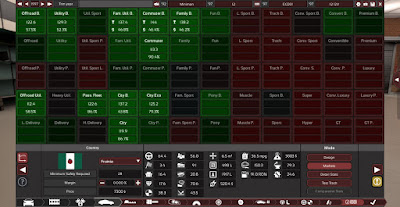Confessions of an Automationeer, Part 54: The Shrike Strikes Back
After a series of poor results in recent CSRs, I skipped CSR88 voluntarily, knowing that the theme for the next one would be more to my liking. And much to my relief and joy, it was. But before we get to that, here's a rundown of its premise.
Some time in 1991, an East German woman named Janny is unexpectedly coping very well with living in a reunified, democratic Germany, devoid of the austerity that characterized her earlier life under a communist government. Her previous car wouldn't cut it anymore, so to reward herself, she seeks to buy a compact convertible which is attractive, fun to drive, practical, comfortable, and above all cheap to buy and run. However, she had only $9000 to spend, and on top of that, the production unit and engineering time limits for the engine and trim were fairly tight. Due to my expertise in building budget cars, I jumped at the chance to build an entry - but this time I decided to put a bit more care into its design and engineering than in any of the past few rounds in which I entered, and it showed.
The Morton Shrike 1.8 Cabrio - a small convertible so cheerful it won't let you down even on a rainy day.
After several hours, I came up with a small, curvaceous car, which I called the Morton Shrike 1.8 Cabrio. This was the predecessor to my CSR87 entry, but unlike that car, it had an all-iron, single-overhead-cam, normally aspirated, 16-valve 1.8-liter inline-four developing a modest 100 horsepower mated to a four-speed automatic transmission. Combined with the conservative suspension tune, brake setup and small-diameter tires, this resulted in the Shrike Cabrio being more of a casual bruiser than a back-road bruiser. Even so, it still felt lively enough to cut the mustard as a fun car, as we shall soon see.
As time went on, more and more users showed off their entries, but I remained as confident as ever. By the time the deadline had passed, the entry list had swollen to a staggering 42 entries. This would be a nightmare for most users to process, but the host promised that the whole review phase, from the initial reviews to the final results, would all be completed. And indeed they were - although due to work commitments, they took somewhat longer than anticipated. Eventually, however, my patience was rewarded when the list of finalists was announced - and much to my relief, my little Shrike was among the 11 cars which had been shortlisted.
With the remaining 31 cars having been rejected for falling short in at least one of the major criteria, it was time for a more thorough examination of the finalists, and the only way for Janny to do that was to do a brief test drive of each one. It was during this stage that the Shrike really came into its own. Janny found it to be attractive, well-equipped, and reasonably comfortable with a modicum of sportiness. However, although this was true of most of the finalists (to some extent), the Shrike managed it better than most. Thus, after further deliberation, the bright yellow Shrike remained in contention along with seven other entries.
In the end, the Shrike claimed a tie for second with the Solo Checker, with the FAAL Mesaia taking the overall win - but only just, and even then it had a manual gearbox for sportiness' sake at the expense of drivability and comfort, although in all honesty, it was still a doddle to drive, as Janny had expected it to be. I suspect that the only thing holding back the little Shrike was my decision to use pricier all-season instead economy tires - but they were so narrow, and wrapped around such small wheels (14 inches in diameter), that they were still fairly cheap. Even so, I remain proud of my entry for this round for several reasons. Not only was this the first time I was a finalist in any CSR round for a long time, I had just returned to the contest after skipping the previous round.
In the end, the Shrike claimed a tie for second with the Solo Checker, with the FAAL Mesaia taking the overall win - but only just, and even then it had a manual gearbox for sportiness' sake at the expense of drivability and comfort, although in all honesty, it was still a doddle to drive, as Janny had expected it to be. I suspect that the only thing holding back the little Shrike was my decision to use pricier all-season instead economy tires - but they were so narrow, and wrapped around such small wheels (14 inches in diameter), that they were still fairly cheap. Even so, I remain proud of my entry for this round for several reasons. Not only was this the first time I was a finalist in any CSR round for a long time, I had just returned to the contest after skipping the previous round.
Above: The FAAL Mesaia won CSR89 by the slimmest of margins, but the Morton Shrike ran it very close... Below: ...as did the Solo Checker.
As mentioned above, the reviews and results took quite a while to complete, but at least I could look back on one of the most compelling low-budget CSR rounds thus far with a mixture of joy and relief, now that it has come to an end - later than expected, no doubt, but still satisfactorily concluded nonetheless. Speaking of which, the user who hosted this round couldn't manage it the first time he assumed hosting duties; we are grateful that he learned his lesson this time around.
This concludes my summary on CSR89. More posts about CSR are forthcoming, so stay tuned.




































